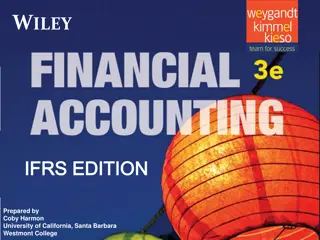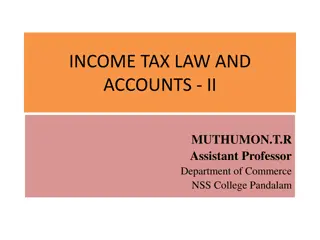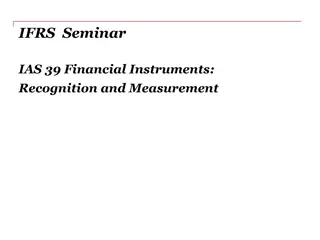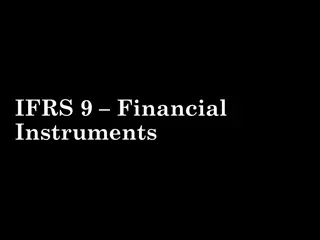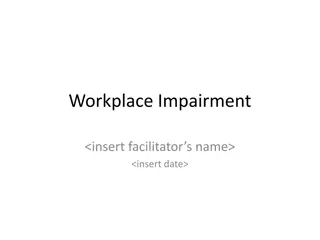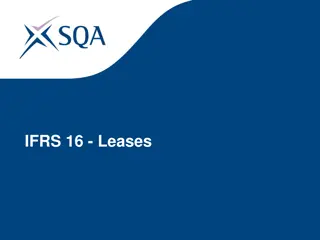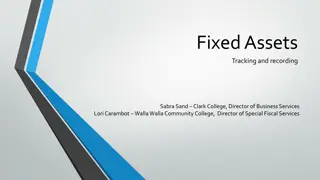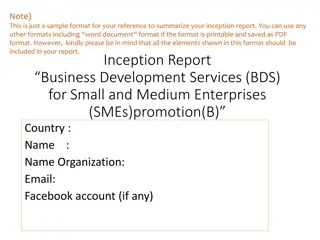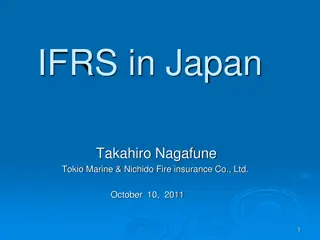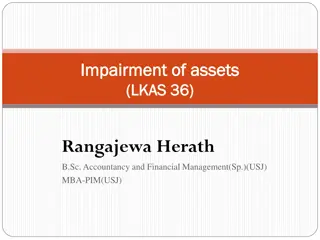Understanding Impairment of Assets in IFRS for SMEs - 2019
This content discusses the Impairment of Assets in IFRS for SMEs, focusing on determining the true economic benefits of assets for accurate financial representation. It covers exceptions, impairment tests, inventory valuation, and recognizing valuation/impairment losses for inventory categories. A calculation example for valuation loss is provided based on accounting records.
Download Presentation

Please find below an Image/Link to download the presentation.
The content on the website is provided AS IS for your information and personal use only. It may not be sold, licensed, or shared on other websites without obtaining consent from the author. Download presentation by click this link. If you encounter any issues during the download, it is possible that the publisher has removed the file from their server.
E N D
Presentation Transcript
IFRS for SMEs Impairment of Assets - 2019 1
Impairment of Asset Prepared by: Rashied Small, Prof. Jade Jansen, Yaeesh Yasseen, et al Impairment of Assets - 2019 2
Impairment of Assets - Introduction Objective: determine the true economic benefits (carrying amount) of the assets to ensure faithful representation of the financial statements Exceptions: the concept of impairment of assets of assets (standard) excludes certain assets such as: Inventory valuation at lower of cost or net realizable value Debtors valuation based on recoverability (provision for doubtful debt and in terms of IAS 9) Investment Property fair valuation model (carrying amount s stated at its fair value) 3 Impairment tests must be performed at the end of each reporting period Impairment of Assets - 2019
Impairment of Inventory Inventory standard has its internal impairment test valuation at the lower of cost or net realization value Inventory loss (loss suffered as a result of inventory theft) must not be confused with the valuation loss (impairment loss) Recognition of an inventory loss should be treated as an operating expense, while the valuation loss should be treated as a trading expenses (cost of goods sold) Acceptable that both inventory loss and valuation loss be recognized in cost of goods sold 4 Impairment of Assets - 2019
Impairment of Inventory Recognising the valuation/impairment loss for inventory: Loss is calculated for each inventory category independently Total loss for inventory is limited to the valuation loss for finished goods The valuation loss is allocated to the inventory categories from the lowest level in the production process (raw materials to finished goods) The following information was extracted from the accounting records: Cost NRV Raw material 123,800 102,600 Work-in-progress 317,900 317,900 Finished goods 478,300 440,000 5 Required: Calculate the valuation loss for current period Impairment of Assets - 2019
Impairment of Inventory Cost NRV Loss Raw material 123,800 102,600 21,200 Work-in-progress 317,900 317,900 - Finished goods 478,300 440,000 38,300 Total value 920,000 860,500 59,500 Maximum loss recognized (finished goods) 38,300 Allocation: Materials 21,200 : Finished goods 17,100 Debit Credit Cost of goods sold 38,300 Inventory - Raw material 21,200 Inventory Finished goods 17,100 [Recognition of valuation loss for the period] 6 Impairment of Assets - 2019
Impairment of Inventory Although SARS allows inventory to be valued based on the method and valuation reported in the financial statements: The valuation loss for tax purposes is limited to the losses realized from damage to the goods certain selling expenses may not be allowed to reduce the value of the inventory Difference between the valuation of inventory for accounting and tax purposes will result in deferred tax implications 7 Impairment of Assets - 2019
Trade Receivables Trade receivables are valued at the reporting date based on an estimate of the future recoverability of the amount due from debtors Recognition of provision for doubtful debts based on management judgement (estimated percent of the amount outstanding) Deduction allowed for the provisions for doubtful debts for tax purposes has changed based on the analysis of the individual account balance rather than an estimated percentage on the overall balance Differences between the balances of trade receivables for accounting and tax purposes will result in deferred tax 8 Impairment of Assets - 2019
Impairment of Investment Property Investment Property are not depreciated and should be valued at its fair value at each reporting date Fair value adjustment can result in both an increase or decrease in the carrying amount (decrease is recognized as an impairment) In subsequent periods the loss recognized can be reversed as a result of the increase in the fair value For income tax purposes, properties which are classified as Investment Properties may be subjected to capital allowances for tax purposes Differences between the carrying amount for accounting and tax purposes will result in deferred tax 9 Impairment of Assets - 2019
Impairment of Investment Property The rate used to calculate the deferred tax relating to Investment Property will depend on the intention of realizing the future economic benefits: Through use: the company tax rate should be applied Through disposal: capital tax principles should be applied At the reporting date the carrying amount and fair value of Investment Property were R 2,300,000 and R 2,100,000 respectively. Cost of the property was R 1,850,000 property is not subjected to annual allowance for tax purposes. Fair value loss 200,000 10 Deferred tax @ 28% 56,000 Impairment of Assets - 2019
Other Assets - PPE Impairment loss is determined by comparing the carrying amount based on historical cost method and the recoverable amount. Recoverable amount is calculated based on: Selling price less selling expenses (if there is an active market), or Value in use determined based on an acceptable valuations method (if there is not an active market) Higher of the selling price less costs to sell and the value in use (conservatism approach of accounting) 11 Impairment of Assets - 2019
Other Assets - PPE The following information was extracted from the accounting records at the reporting date for Machinery: Cost of machinery 2,500,000 Accumulated depreciation 1,200,000 Selling price less cost to sell 1,100,000 Value in use 1,000,000 Recoverable amount (higher) 1,100,000 Carrying amount 1,300,000 Debit Credit Impairment loss 200,000 Accumulated impairment loss 12 200,000 Impairment of Assets - 2019
Depreciation after Impairment After an asset has been impaired, the revised carrying amount (recoverable amount) should be depreciated over the remaining useful life of the asset. The following information was extracted from the accounting records at the reporting date February 2016: Machinery (cost) March 2013 1,200,000 Accumulated depreciation 300,000 Residual value 200,000 Estimated useful life 10 years Recoverable amount 770,000 13 Required: Record the journal entries for the reporting dates 2016 and 2017. Impairment of Assets - 2019
Depreciation after Impairment Carrying amount 900,000 Recoverable amount 760,000 Selling price less cost to sell 140,000 Remaining useful life 7 years Depreciation (2017) 90,000 Debit Credit Impairment loss 140,000 Accum. impairment loss 140,000 Depreciation expense 90,000 Accum. Depreciation 90,000 14 Impairment of Assets - 2019
Reversal of Impairment Loss If subsequent to the recognition of an impairment loss the recoverable amount exceeds the carrying amount of the asset, then the asset should be reflected at its recoverable amount resulting in: Reversal of the impairment loss previously recognized Reversal is limited to re-instated the asset at its carrying amount based on the historical cost method (before the impairment of the assert) 15 Impairment of Assets - 2019
Reversal of Impairment Loss The following information was extracted from the accounting records: Machinery costs (2014) 3,000,000 Carrying amount (2016) 1,800,000 Recoverable amount (2016) 1,500,000 Remaining life (2016) 6 years Recoverable amount (2018) 1,290,000 Required: Record the journal entries for the reporting dates 2018. 16 Impairment of Assets - 2019
Reversal of Impairment Loss Cost Impaired Carrying amount (2016) 1,800,000 1,500,000 Depreciation (2018) 600,000 500,000 Carrying amount (2018) 1,200,000 1,000,000 Recoverable amount 1,290,000 Reversal/Limitation 200,000 290,000 Reversal of impairment loss cannot re-instate the carrying amount to be greater than R 1,200,000 Debit Credit Depreciation expense 250,000 Accum. Depreciation 250,000 Reversal of impair. Loss 200,000 17 Accum. Impairment loss 200,000 Impairment of Assets - 2019
Cash Generating Unit A cash-generating unit is the smallest group of assets that independently generates cash flow and whose cash flow is largely independent of the cash flows generated by other assets. CGU should be tested for impairment similar to the principles applied for inventory, viz. tested individually but the impairment loss is limited the loss for the CGU. The recoverable amount of the CGU should only be based on the assets which are included in the standards governing the impairment of assets. Allocation of the impairment loss for the CGU is as follows: Write of Goodwill in full Allocation the loss on a proportionate basis to remaining assets (carrying amounts) Loss allocated cannot exceed the loss for the individual asset 18 Impairment of Assets - 2019
Cash Generating Units The following information was extracted from the accounting records relating to a Cash Generating Unit: Recoverable amount Cost Goodwill 120,000 120,000 Machinery 1,350,000 1,100,000 Equipment 560,000 500,000 Inventory 345,000 320,000 Trade receivables 490,000 475,000 Total 2,865,000 2,515,000 Required: Calculate the impairment loss for the CGU and the individual assets. 19 Impairment of Assets - 2019
Cash Generating Units Impairment Loss Allocated loss Cost % Goodwill 120,000 120,000 Machinery 250,000 71% 134,900 Equipment 60,000 29% 55,100 Total 310,000 310,000 Total impairment loss for the CGU should exclude inventory and debtors (internal impairment valuation) R 310, 000 (2,030,000 1,720,000) Impairment loss allocated for the remaining assets, after writing off Goodwill to zero is based on the proportion of the cost composition: Machinery: (310,000 120,000) x 71% = R 134,900 Equipment: (310,000 120,000) x 29% = R 55,100 20 Impairment of Assets - 2019
21 Impairment of Assets - 2019
22 Impairment of Assets - 2019
JOIN THE CONVERSATION AND BE #SAIPAproud @SAIPAcomms South African Institute of Professional Accountants SAIPA-South African Institute of Professional Accountants Impairment of Assets - 2019 23







